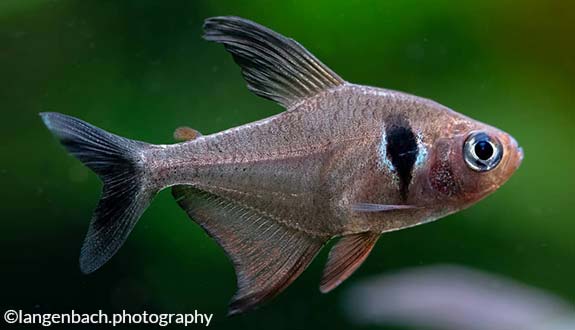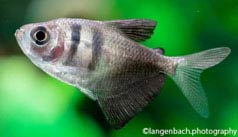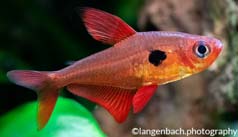

Alternative species (click on the thumbnail to see the card)
Names
Scientific name
Hyphessobrycon megalopterus
Megalamphodus-megalopterus
Megalamphodus rogoaguae
Common name
Black phantom tetra
Phantom tetra
Origin

Origin: Brazil, Bolivia
Biotope: Amazonian
Dimorphism
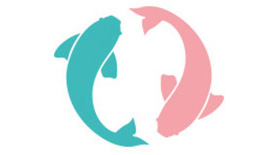
Quite easy: males have a more developed dorsal fin. The pectoral fins of females are red (see "Good To know").
Group
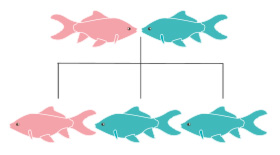
Characidae
Volume

120 L / 26 Imp Gal / 32 US Gal
Parameters

T°: 24 to 26°C or 75 to 79°F
pH: 6 to 8
Hardness: 1 to 8°dGH
Difficulty

Easy
Size

4.5cm (1.6")
Longevity

4 to 5 years
Living zone

Middle
Individuals

10
Food
How to feed the Black phantom tetra?
Food
How to feed the Black phantom tetra?
This fish is easy to feed. It's an omnivore that will accept anything you offer it. But that's no excuse to feed it only freeze-dried food! Take care to vary its meals, especially with live or frozen prey such as mud worms, red daphnia, artemia...
Some recalcitrant fish will sometimes spit out food such as flakes or granules, to consume only live or frozen prey.
Behavior
What kind of behavior does the Black phantom tetra have?
Behavior
What kind of behavior does the Black phantom tetra have?
The Phantom Tetra is a peaceful but lively fish that will peacefully animate your aquarium. It can provide a nice contrast to more colourful fish.
They like to take shelter in the shade of plants, but they will still move around a lot.
The love parade of males will surely surprise you, but don't worry, it is perfectly harmless for the protagonists. They fully unfurl their beautiful fins and start to turn in circles.
Cohabitation
Who can live with the Black phantom tetra?
Cohabitation
Who can live with the Black phantom tetra?
Like all Tetras, it is imperative to satisfy the gregarious instinct of these fish and to keep them in groups of at least 10 individuals (you will then need a tank of at least 120 litres / 26 Imp Gal / 32 US Gal). Did you know that in the wild, they form gigantic schools of several thousand individuals?
In terms of association with other species, the Black phantom tetra is compatible for a community aquarium. It will easily associate with all other peaceful and not too large fish species. We can quote for example (nonexhaustive list): Apistogramma, Rasbora, Tetra...
Be careful that its lively temperament does not disturb the other occupants of the tank. Indeed, it can be turbulent, which could bother more timid species such as Corydoras for example. Finally, beware of predation by phantom tetra on juvenile shrimp.
Breeding
How to breed the Black phantom tetra?
Breeding
How to breed the Black phantom tetra?
The reproduction of this species is quite difficult for most aquarists. Indeed, even if the female expels many eggs, the males are often reluctant to fertilize them. However, we suggest this protocol.
Prepare a 20-litre (4 Imp Gal / 5 US Gal) aquarium equipped with a small filter (pearl + peat), a heater and fine-leafed plants such as java moss and Myriophyllum. Use floating plants to strongly dim the light because the aquarium must be very dark (eggs are afraid of light). The ideal water parameters are a temperature of 26°C (79°F) and a pH of 5/6 and a Gh of 5. If necessary, use osmosis water to achieve these parameters.
Introduce a couple that you have selected into this tank, preferably in the evening (they should be between 8 and 10 months old for a better chance of success). The spawning is very visible, the male coming to stick to the female's side. The female expels about 200 eggs by making sharp turns. The eggs come to stick to the plants. They are brown/red. As soon as they appear, remove the parents and be very careful with the light that deteriorates the eggs (do not hesitate to protect your breeding aquarium more at this stage).
Incubation lasts 24 hours. At birth, the fry tend to remain at the bottom of the tank and then settle on the surface. They swim freely after the 6th day, but most of the time they remain hidden in the plants. The growth is rather slow.
Gradually add harder water to accustom the young. Do the same for the light, which should return gradually.
Feeding the fry: infusers, small nauplias of artemia or cyclops for at least 5 weeks.
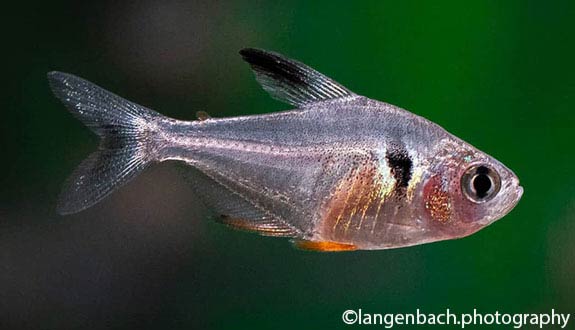
Its aquarium
Which aquarium for the Black phantom tetra?
Its aquarium
Which aquarium for the Black phantom tetra?
First of all, give your fish a nice swimming space by choosing an aquarium with at least 80 cm (31.5") of frontage.
In its natural environment, this Tetra lives in clear, shallow river water. Replicate these conditions in your aquarium by offering clear water to your Tetra ghosts. The filtration, without creating too much current, must still allow a good oxygenation of the water. Count at least two to three times the volume of the tank per hour. To encourage gas exchanges, do not hesitate to place the filter's discharge just below the surface of the water to create eddies.
For decoration, reproduce their natural environment by planting your aquarium densely but leaving enough room for swimming (you can, for example, install your vegetation on the sides and bottom of the tank). Thin-leaved plants will make your fish stand out even more. Finally, floating plants are essential for the Tetra to feel safe.
Add a few bog roots to complete your decor.
For the soil, opt for a dark colour: this will make the Tetra feel safe and bring out its delicate colouring!
Good To know
Find all additional information!
Good To know
Find all additional information!
Robust, easy to maintain and sold frequently, the Tetra Ghost is an excellent choice for beginners in aquarium keeping.
It has a tendency to fall down if it is kept in too hard water.
This fish belongs to the large Characidae family, which includes more than 1000 species!
The sexual dimorphism is quite obvious:
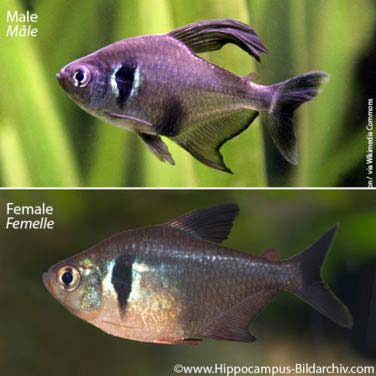
Yours photos!
Comments
Sort by:
Please login to post comments
